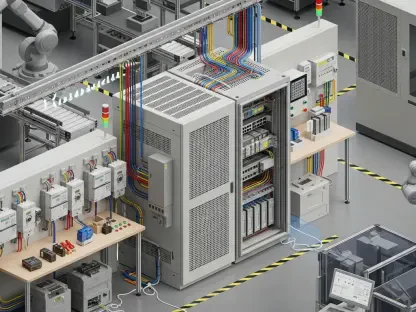The industrial landscape of the United States is experiencing a seismic shift as automation becomes a cornerstone of operational strategy, with Automated Guided Vehicle (AGV) systems leading the charge in transforming manufacturing, logistics, and warehousing sectors. These sophisticated systems, which combine cutting-edge software and hardware, are not merely tools but strategic assets that enable industries to slash costs, enhance efficiency, and maintain a competitive edge on the global stage. Projections paint a striking picture of growth, with the market for AGV intelligent management systems expected to soar from USD 1.8 billion currently to USD 5.2 billion by 2035, reflecting a robust compound annual growth rate (CAGR) of 11%. This near tripling of market value over a decade signals a profound economic impact, promising a total increase of 184.2% and a sales expansion of approximately 2.84 times. As industries grapple with the demands of a fast-paced, technology-driven world, the integration of artificial intelligence (AI), cloud computing, and real-time monitoring within AGV systems positions them at the forefront of the Industry 4.0 revolution. This article aims to unpack the driving forces behind this remarkable surge, exploring technological innovations, key applications, regional dynamics, and the challenges that accompany such rapid advancement.
Economic Outlook and Market Expansion
Trajectory of Financial Growth
The projected expansion of the AGV market from USD 1.8 billion at present to USD 5.2 billion by 2035 stands as a testament to the transformative power of automation in American industry, highlighting the accelerating pace at which sectors like manufacturing and logistics are embracing these intelligent systems. This remarkable 184.2% increase over the span of a decade underscores the rapid adoption of such technologies. With a consistent CAGR of 11%, the market is on track to double in value roughly every six to seven years during this period. Such growth is not just a numerical milestone but a reflection of broader shifts in industrial priorities, where efficiency and cost reduction are paramount. The economic implications extend far beyond direct revenue, influencing everything from supply chain responsiveness to operational downtime, ultimately bolstering the profitability of enterprises that adopt these technologies. As the United States solidifies its position as a leader in industrial automation, the robust infrastructure and established manufacturing base provide fertile ground for this market to flourish.
Delving deeper into the economic ripple effects, the adoption of AGV systems is reshaping the labor landscape by shifting job roles toward more technical and supervisory positions. This transition, while potentially reducing the need for manual labor, creates a demand for skilled workers capable of managing and maintaining advanced automation systems. The reduction in operational costs through minimized errors and enhanced throughput offers industries a competitive advantage, particularly in a global market where efficiency often dictates success. Furthermore, the projected sales expansion of 2.84 times underscores the cascading benefits of automation, as businesses reinvest savings into innovation and expansion. This cycle of growth positions AGV systems as a critical driver of national productivity, with the potential to redefine industrial competitiveness across diverse sectors over the coming years.
Phases of Market Development
Breaking down the growth trajectory into distinct phases reveals the nuanced patterns of AGV adoption across American industries. From the current valuation of USD 1.8 billion to an estimated USD 3,052.8 million by 2030, the market is expected to add USD 1,205.5 million in just five years. This initial phase is characterized by early adopters, particularly in manufacturing hubs, who are integrating AGV systems to address immediate needs for operational efficiency. These pioneers are often driven by the pressing demand to streamline processes and reduce labor costs in high-volume environments. The focus during this period is on proving the value of intelligent management systems, with investments targeted at scalable solutions that can adapt to evolving industrial demands. This early momentum sets a strong foundation for broader acceptance across various sectors.
The subsequent phase, spanning from 2030 to 2035, anticipates an even more significant leap, with the market adding USD 2,195.9 million to reach the projected USD 5.2 billion. This accelerated growth reflects wider adoption spurred by advancements in logistics applications and the penetration of AGV systems into diverse fields such as automotive and new energy production. During this period, the technology is expected to mature, with innovations in fleet coordination and real-time monitoring becoming more accessible to smaller operators. The increasing complexity of supply chains and the push for just-in-time inventory models further amplify the need for such systems, driving demand in regions with dense industrial activity. This latter phase illustrates a market reaching critical mass, where AGV systems become integral to maintaining competitiveness in a rapidly evolving global economy.
Technological Frontiers in AGV Systems
Dominance of Cloud-Based Solutions
Cloud-based AGV management systems are emerging as the backbone of modern industrial automation, commanding a substantial 62.8% market share at present. Their appeal lies in the unparalleled scalability they offer, allowing facilities to expand their AGV fleets without the burden of significant hardware investments. This flexibility is particularly crucial for businesses operating in dynamic environments where operational needs can shift rapidly. Beyond scalability, cloud platforms facilitate seamless integration with existing systems, enabling manufacturers and logistics providers to avoid costly overhauls of infrastructure. The ability to access real-time data and manage fleets remotely further enhances their value, as operational issues can be addressed with minimal delay, thereby boosting overall productivity. This dominance signals a broader trend toward digital solutions that prioritize adaptability and efficiency.
Another critical advantage of cloud-based systems is their role in democratizing access to advanced automation technologies. By reducing the need for extensive on-site IT infrastructure, these platforms lower the entry barrier for smaller operators who might otherwise struggle with the upfront costs of automation. The subscription-based models often associated with cloud solutions also align with budget constraints, offering predictable expenses over time. Additionally, the enhanced security features embedded in modern cloud systems address concerns about data protection, ensuring that sensitive operational information remains safeguarded. As industries continue to navigate the complexities of digital transformation, the preference for cloud-based AGV management systems is likely to grow, solidifying their position as a cornerstone of industrial efficiency.
Advancements in AI and Connectivity
The integration of artificial intelligence (AI) into Automated Guided Vehicle (AGV) systems marks a significant leap forward in their capability to optimize industrial operations. AI algorithms are increasingly used to enhance navigation, allowing AGVs to adapt dynamically to changing environments and avoid obstacles with precision. Predictive maintenance, another key application of AI, helps anticipate equipment failures before they occur, minimizing downtime and extending the lifespan of vehicles. In high-traffic settings such as warehouses, AI-driven systems can adjust routes in real time based on inventory demands or congestion, significantly increasing throughput. This intelligent coordination reduces human intervention, allowing for smoother, more efficient workflows that align with the fast-paced demands of modern industry.
Complementing AI advancements, cutting-edge connectivity solutions like 5G are revolutionizing how AGVs communicate with central management platforms. The high-speed data transfer enabled by such technologies ensures seamless interaction, which is vital for real-time decision-making in dynamic industrial settings. This connectivity supports a higher density of AGVs operating simultaneously without performance lags, a critical factor in large-scale facilities where dozens or even hundreds of vehicles may be in use. Furthermore, the reliability of these networks minimizes disruptions, ensuring that operations continue smoothly even under peak loads. As connectivity infrastructure continues to expand across the United States, the synergy between AI and advanced networks will likely drive further innovation in AGV systems, enhancing their role as indispensable tools in automation.
Key Applications and User Needs
Central Role of Stereo Warehousing
Stereo warehousing stands out as a primary driver of AGV system demand, holding a commanding 44.7% market share at present. This segment, encompassing distribution centers, fulfillment operations, and automated storage facilities, relies heavily on AGVs to streamline material handling and reduce dependency on manual labor. The ability of these systems to navigate complex layouts and handle diverse load types makes them ideal for environments where speed and accuracy are critical. In regions with dense logistics networks, such as the West and Northeast, the demand for AGVs in stereo warehousing is particularly pronounced, fueled by the exponential growth of e-commerce and the need for rapid order fulfillment. The push for just-in-time inventory models further amplifies the necessity for automated solutions that can keep pace with fluctuating consumer demands.
Beyond operational efficiency, the adoption of AGVs in stereo warehousing addresses broader supply chain challenges, such as labor shortages and rising costs, ensuring smoother and more cost-effective operations. By automating repetitive tasks like pallet movement and inventory tracking, these systems free up human workers for more strategic roles, enhancing overall productivity. The integration of AGVs with warehouse management software also provides actionable insights through real-time data, enabling better decision-making and resource allocation. As logistics hubs continue to expand to meet the demands of a digital economy, the role of AGV systems in optimizing space utilization and minimizing errors becomes even more vital. This focus on stereo warehousing underscores the transformative impact of automation on one of the most critical components of modern commerce.
Versatility Across Industrial Sectors
AGV systems are proving their versatility beyond warehousing, with significant applications in automotive manufacturing where precision and safety are paramount. On assembly lines, AGVs transport materials and components with exacting accuracy, reducing the risk of human error and ensuring seamless production flows. This application is particularly crucial in an industry where timing and quality directly impact market competitiveness. The controlled environments of automotive plants also benefit from the ability of AGVs to operate under strict protocols, minimizing disruptions and enhancing worker safety. As manufacturers strive to meet increasing consumer demand for vehicles, the reliance on automated solutions to maintain efficiency is expected to grow steadily over the coming years.
The new energy sector, particularly in the production of batteries for electric vehicles, represents another emerging frontier for AGV systems, where handling sensitive materials under stringent environmental controls requires a level of precision that AGVs are uniquely equipped to provide. Meanwhile, end-user diversity shapes market dynamics, with manufacturers focusing on cost reduction through streamlined production, and logistics providers prioritizing scalability to manage large fleets in distribution centers. Industrial facilities across various sectors also adopt AGVs for tailored material handling solutions, highlighting the technology’s broad applicability. This wide range of uses illustrates how AGV systems are not confined to a single niche but are instead reshaping operational strategies across multiple industries, each with distinct priorities and challenges.
Regional Dynamics and Growth Patterns
Innovation Hubs in the West and Northeast
The West region of the United States emerges as a frontrunner in AGV system adoption, boasting a projected CAGR of 12.1% through 2035, largely due to innovation hubs in states like California. There, technology firms and advanced manufacturing clusters drive early adoption of cutting-edge automation solutions. The region’s progressive policies on industrial automation, combined with access to substantial venture capital, create an environment conducive to rapid technological deployment. Major manufacturers in the West are investing heavily in next-generation AGV technologies, such as autonomous navigation and AI-driven optimization, setting benchmarks for national standards. This momentum positions the West as a pacesetter, influencing adoption trends across other areas of the country.
Following closely, the Northeast region projects a strong CAGR of 11.4%, supported by its dense industrial and logistics infrastructure, which plays a crucial role in driving growth. States like New York and Pennsylvania, with deep roots in automotive and aerospace manufacturing, are modernizing operations through AGV integration to sustain competitiveness. The concentration of logistics operations, especially near major ports, fuels demand for stereo warehousing applications, where AGVs enhance throughput in high-volume distribution centers. The Northeast benefits from a combination of operational efficiency requirements and favorable industrial demographics, making it a vital contributor to the national market. This region’s established industrial base ensures that AGV adoption is both strategic and sustainable, reinforcing its role as a key player in automation growth.
Modernization in the Midwest and South
The Midwest, with a projected CAGR of 10.8%, leverages its rich manufacturing heritage to drive AGV system adoption, particularly in states like Michigan and Ohio, which are known for automotive and heavy industry. Modernization efforts in industrial facilities are a primary catalyst, as companies integrate intelligent management systems to address labor shortages and rising operational costs. The focus on enhancing efficiency and maintaining competitiveness in global supply chains propels steady demand for AGVs, with investments often targeting automation to streamline production processes. Regional supply infrastructure development further supports this growth, ensuring access to necessary technology and integration services. The Midwest’s commitment to updating its industrial capabilities underscores its significant role in the national automation landscape.
The South, growing at a CAGR of 10.2%, benefits from expanding industrial activity and increasing investments in automation across various sectors. States in this region are witnessing a surge in manufacturing and logistics facilities, driven by favorable economic conditions and strategic geographic positioning. AGV systems are becoming integral to these new and upgraded operations, supporting efforts to optimize material handling and reduce costs. The slightly slower growth rate compared to other regions reflects a catch-up dynamic, as the South builds on recent industrial expansions to close the gap with more established automation hubs. This trajectory highlights a balanced national market where each region contributes unique strengths, collectively pushing the boundaries of industrial automation through AGV adoption.
Challenges and Competitive Landscape
Barriers to Adoption and Implementation
Despite the promising outlook for AGV systems, significant challenges persist that could temper the pace of adoption across American industries. High upfront costs remain a formidable barrier, particularly for smaller operators or facilities with limited capital to invest in automation infrastructure. The initial investment in hardware, software, and system integration often requires a long-term perspective to justify the expense, which can deter companies focused on short-term financial goals. Additionally, the complexity of integrating AGV systems with legacy equipment poses technical hurdles, as older systems may lack compatibility with modern intelligent management platforms. This mismatch can lead to costly retrofitting or complete overhauls, further straining budgets and resources.
Beyond financial and technical obstacles, the need for specialized expertise to operate and maintain AGV systems presents another layer of difficulty, making implementation a complex process for many industries. Skilled technicians and engineers are essential for ensuring optimal performance, yet the current shortage of qualified personnel in many industrial sectors exacerbates these challenges. Training programs and educational initiatives are necessary to bridge this gap, but developing a workforce capable of handling advanced automation takes time and investment. Addressing these barriers requires strategic solutions, such as phased deployment plans that spread costs over time and partnerships with technology providers to facilitate integration. Overcoming these hurdles is critical to unlocking the full potential of AGV systems in transforming industrial operations.
Innovation and Market Competition
The competitive landscape of the AGV market is marked by intense innovation, with major players like Dematic holding a significant 19.2% share through comprehensive and cutting-edge solutions. Companies in this space are engaged in a race to develop advanced features such as AI-driven optimization and seamless cloud integration, aiming to capture greater market share by meeting the evolving needs of industrial clients. Strategic partnerships with technology suppliers and end users are also a common approach, enabling firms to tailor solutions to specific operational demands and enhance scalability. This dynamic environment fosters continuous improvement, as competitors strive to outpace each other in delivering reliable and efficient AGV systems.
Collaboration extends beyond individual companies to include broader stakeholder engagement, involving government bodies, industry associations, and research institutions. These alliances are pivotal in addressing market challenges, such as integration complexities and cost barriers, through shared infrastructure investments and standardized practices. The emphasis on collaborative innovation ensures that advancements benefit a wide range of industries, from logistics to manufacturing, while maintaining accessibility for smaller players. As competition intensifies, the focus on delivering value through customized solutions and robust support services becomes increasingly important. This vibrant ecosystem of rivalry and cooperation is shaping the future of AGV systems, driving the market toward greater heights of efficiency and adoption.
Future Pathways for AGV Integration
Strategies for Overcoming Obstacles
Looking back, the journey of AGV systems in the United States reflected a determined push toward automation, grappling with high initial costs and integration challenges that tested the resilience of industrial sectors. Stakeholders tackled these issues head-on by advocating for phased implementation strategies that allowed companies to spread expenses over manageable timelines, reducing the financial strain of adopting advanced technologies. Partnerships between technology providers and end users played a crucial role, offering tailored integration support to bridge the gap between legacy systems and modern platforms. Additionally, investments in workforce training programs addressed the shortage of skilled personnel, ensuring that operators were equipped to handle sophisticated AGV systems. These efforts laid the groundwork for broader acceptance and set a precedent for overcoming systemic barriers through collaboration.
Building a Sustainable Automation Ecosystem
Reflecting on past efforts, the development of a sustainable automation ecosystem emerged as a critical focus, with government initiatives and industry collaborations proving instrumental in scaling AGV adoption. Enhanced safety guidelines and standardized performance metrics were established to ensure consistent quality across deployments, while R&D funding fueled innovations that made systems more accessible and efficient. Public-private partnerships became a linchpin for future growth, supporting infrastructure investments that lowered entry barriers for smaller operators. Moving forward, a commitment to continuous policy refinement and stakeholder engagement offers a clear path to sustaining this momentum, ensuring that AGV systems remain a vital component of industrial progress while addressing emerging needs and technological advancements.









